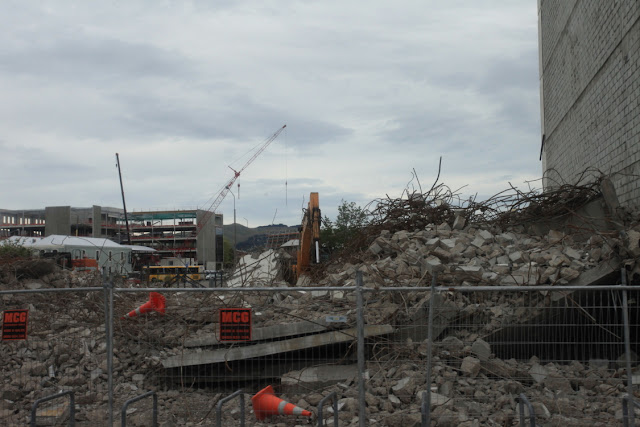After five years many buildings still stand dilapidated and unusable
 But in some respects there is a good reason for this - the city has decided to completely recycle all of the waste rather than just dump it. The concrete is being crushed from each building and used in new aggregate. The steel rebar is being recycled. Everything is being repurposed and so the demolition going much more slowly than one would expect as normal.
But in some respects there is a good reason for this - the city has decided to completely recycle all of the waste rather than just dump it. The concrete is being crushed from each building and used in new aggregate. The steel rebar is being recycled. Everything is being repurposed and so the demolition going much more slowly than one would expect as normal.Anywhere there is an empty lot signifies a place where a building (usually multi-story) has been demolished. On this lot, 181 plastic chairs are a reminder to those who lost their lives. 115 people were killed in the collapse of one building. Eight were killed while riding in a Red Bus (city transport) when a building wall fell on the bus. One American was among the many fatalities.
Map showing the epicenters of two main shocks and their many aftershocks. The September 4, 2010 Darfield quake has a green star and green circles, while the February 22, 2011 Christchurch earthquake has a red star and red circles. The rupture lines are also shown with a solid red line denoting a previously recognized surface fault trace and yellow dashed as sub-surface. Some geologists propose that the less intense Christchurch quake is an aftershock of the Darfield quake, while others pointing out that they were on two separate faults and thus separate events. It looks to me like the ruptures are 'on strike' and thus perhaps related. Note the obvious rounded mountain in the lower right of the map. This is the Banks Peninsula and it is a late Miocene (11 to 6 Ma) volcano that is now highly eroded and flooded with seawater.
This is the Catholic cathedral and it too is still standing as no one quite knows what to do with it. I have visited cities that were destroyed by the Nazi's (Norway) or leveled by earthquakes in the 17th and 18th centuries (South America). Today, those cities stand strong, having been rebuilt. If the people of Christchurch could only see that life will eventually go on after this tragedy. One day, Christchurch will be a new city but it may take 50 or more years before it fully recovers.
In 1912, Robert Falcon Scott lost his life on a return journey from the South Pole (along with his four companions) only five weeks after Roald Amundsen of Norway beat him to it. A statue of Scott used to stand on the foundation shown here but was toppled during the quake. In 1987 when I returned from my first journey to Antarctica and the South Pole, I took a picture of the statue from this exact spot. I cannot wait to get home and dig out that old photographic slide I have and compare it to this.
We stayed at the new Rydges Hotel only two blocks from the old one - still standing and cleared for reoccupancy. But the chain does not want the building.
One of the biggest reasons for the extensive damage to buildings was the liquefaction that occurred in the soils in and around Christchurch. This composite diagram of a photo (top) of a sand volcano and cartoon (bottom) shows what happened during and immediately after the quake. Water-saturated sand and clay was mobilized during the shaking and structures had no solid foundation to stand on. Look at some incredible photos of the effects of liquefaction here.
The earthquake caused the land surface to sink between two and three feet. Christchurch is prone to more flooding now as a result. This was the cover of GSA Today magazine in March, 2015.
The famous Christchurch Cathedral (Anglican). This used to be in the heart of a vibrant downtown but it stands in ruins with many surrounding building sites full of weeds. Incredible!
Soon after quake, some businesses decided to use ocean going containers as temporary buildings, soon dubbed as Project ReStart. It is now one of the most active business areas in the city and itself a tourist attraction.
The ANZ Bank has a branch here
And there are many other businesses as well. Our tour director experienced her first visit to Christchurch since 2010, suggesting that tourists are beginning to return to Christchurch.
I hardly recognized the place from 1987. Then, it was full of trees and every corner looked like a bit of England. The city was humbled in just 10 seconds of shaking. To read more details about the earthquake, check out this site here. My next posting will be from Mt. Cook National Park.














Hi, I live in the eastern suburbs of Christchurch, which was the hardest hit area. Its good to have people coming into our city to keep us honest onto what we should be doing regarding regeneration work. It is easy to think of our own needs, but we need to have visitor numbers, to support our city going forward. Please keep coming, an please keep informing us. We are all very grateful for your concern and support. CRAIG.H.
ReplyDeleteThanks for reading Criag H. and good luck with the restart - I know it will be awesome ultimately.
ReplyDelete